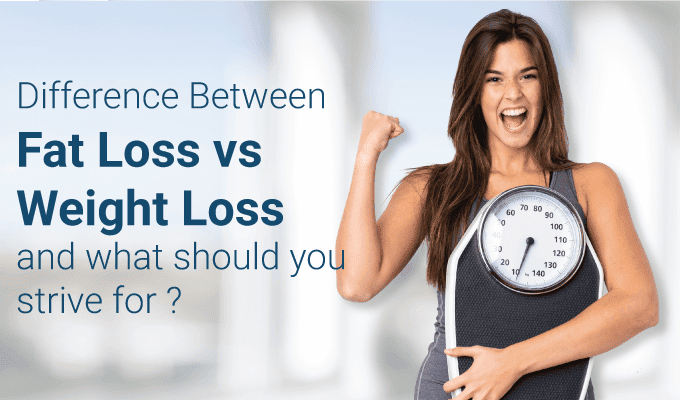Difference Between Fat Loss vs Weight Loss and what should you strive for?
 Ever felt as though your fitness goals are never-ending? Well, there could be numerous reasons for it, but the most important is lack of clarity.
Ever felt as though your fitness goals are never-ending? Well, there could be numerous reasons for it, but the most important is lack of clarity.
Knowing the difference between fat loss and weight loss is vital as both terms are often used interchangeably but are not the same.
Sometimes people work out intending to lose body fat but end up losing weight instead. Thus, recognizing the distinction between losing body fat and weight loss is essential, as it will help you make healthier choices.
Contents
1. What Does Weight Loss Mean?
Bodyweight is the sum of muscle mass, fat mass, body water, and bone mass. Losing extra body weight is an accomplishment for many, but it can backfire as you may lose muscle mass instead of body fat. Faster weight loss may seem like a boon, but if you resort to short-cuts or crash dietary methods, you could end up gaining more fats. This is the reason why planning a well-balanced diet is important. Learn more about weight loss training.
2. What Does Body Fat Loss Mean?
The best way to lose body fat is to add muscle mass and preserve your lean mass. However, shedding all your body fats isn’t healthy either. Your body needs fats to perform critical functions like absorption of fat-soluble vitamins, cushioning internal organs, and providing energy. But, extra body fat can make you store unwanted calories, making you look out of shape. Here, consulting with a dietitian and nutritionist can help you make right choices.
3. Weight Loss and Fat Loss Difference
Weight loss refers to the total drop in the kilogram weight including the weight that you lose out as water weight, fat, and muscle. Body fat loss is just a percentile or a specific drop in body fat levels. People striving to lose weight also lose body fat in the process.
However, unlike weight loss, fat loss can’t be tracked using a weighing scale. It is for this reason why experts point out that seeing the number on the weight scale isn’t a true marker of how much fat or muscle you have lost.
4. Burning Fat vs Losing Weight: What Should You Aim For?
For most people, weight loss is a common fitness goal. However, for healthier body composition, it is better to aim for body fat loss.
Weight loss covers water and muscle loss, which may be detrimental to your overall health. Muscle tissue is essential as it gives your body strength and helps burn extra calories. Water keeps your body hydrated and ensure smooth functioning of the body.
In contrast, losing body fat can help decrease the risk associated with chronic diseases. This includes inflammation, heart disease, diabetes, high blood pressure, high cholesterol, among others. Too much body fat can also lead to obesity.
Read: How to calculate your body mass index
5. Signs You Are Losing Muscles Instead of Fat
- Workouts feel strained: Workouts are tough, and at times you’d prefer skipping them. This might be a sign that your body is losing muscle mass instead of body fat. Having less strength/stamina while working out, being unable to perform a set number of reps, unable to lift regular weight are all signs that you are losing muscle mass.
- The body feels sluggish all day: Not following a healthy diet can cause the body to lose muscle mass, leading to impaired function. This happens due to energy deficits, undernourishment, and sometimes overtraining.
- Fat percentage isn’t changing: Another sign of losing weight is if the number on the scale goes down, but your body fat remains intact. In other words, you will notice your shrinking circumferences, but the body fat remains the same.
- You are losing weight too quickly: This could be another sign of weight loss without fat loss. Also, rapid weight loss is not sustainable. Striking a healthy balance is important for overall general health and well-being.
- Not progressing in your workout: Unable to do more reps or difficulty in lifting more weight indicates loss of muscle mass, not body fat.
6. Tips to Losing Body Fat (And Not Muscle Mass)
- Don’t solely rely on exercise: While exercising small tears are created in your muscles. This is normal, but for daily workouts, these muscle tissues have to repair themselves. This is where diet plays a pivotal role. By not giving your muscles the necessary time to recover, the chances of losing out on strength and eventually muscle mass are high. Most importantly, for weight loss after pregnancy, it is vital to exercise as well as eat healthily.
- Consume protein: The muscle cells present in the body tend to shed protein every day. Hence, replacing them is critical. Ensure that you consume protein with every big meal. You can start your day by having a protein-rich breakfast. You can include eggs, lean meat, cottage cheese, nuts, seeds, or a teaspoon of ghee in your daily diet.
- Don’t cut off carbs completely: Carbs are often eliminated from the diet of people trying to lose weight. However, the focus should not be on cutting carbs. Rather, you should avoid refined and processed carbs such as pasta, white bread, breakfast cereals, pizza dough, etc. These are devoid of fibre, nutrients and bran. Grains such as whole wheat, jowar, bajra, quinoa, and buckwheat should be added to your diet for a steady supply of energy.
- Balance cardio and strength training exercises: Long and repetitive cardio workouts can become monotonous. For weight loss for beginners, it is better to focus on high-intensity interval training (HIIT) as it offers better results and increases muscle mass. Including strength training or weight training in your daily regime can also help maintain muscle mass. Most importantly, keep one day of the week as a rest day. This will give your body and muscles the required time to rest and recover.
- Avoid soda and alcoholic drinks: Staying hydrated is vital not just for losing fat, but also for maintaining muscle and being overall healthy. Sugar sweeten beverages impact metabolism and virtually every bodily function. Hence, avoid drinking soda, sports drinks, and alcoholic drinks. It is safer to drink water as it contains nutrients required to build cells. It also helps improve blood circulation and helps flush out toxins from the body.
- Consume Fibre: Fiber is a necessary nutrient that often gets ignored. Fibre helps maintain weight and regulate bowel movement. It also promotes healthy gut bacteria and prevents constipation. In plant-based foods, fiber is found in whole grains, fruits, legumes, and starchy vegetables. Nuts and seeds are also high in fiber. Plus, berries (raspberries or blackberries) are a storehouse of fiber.
Further reading: How to lose weight after pregnancy
Further reading: Ultimate guide on pre and post workout nutrition
Read: Best exercises for men and women to do at home.
Conclusion
While exercising, losing a small amount of muscle mass along with excess body fat is better than losing just muscle mass. To obtain this, you need to eat healthily and plan a daily workout regime. Consistency is the key to improve your fitness level. If you need help, you can hire a personal fitness trainer. He will help you set realistic, achievable goals and provide diet & nutrition advice.
Read More Blogs: https://www.sudamshelar.in/best-exercises-for-weight-loss/


Leave a Reply